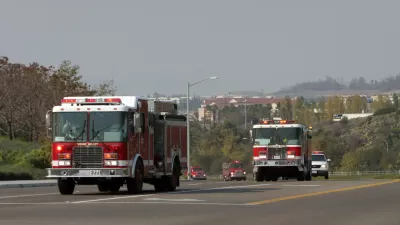Planners and urbanists are familiar with the many instances when fire and life safety codes conflict with quality urban design. The city of San Francisco is currently embroiled in policy conflict over the width of its streets.

"The San Francisco Fire Department has recently fought streetscape improvements and other efforts to make roads safer and more walkable. Even more problematic, the fire department has insisted that in new developments in San Francisco – and we have quite a few of them planned – all roads, including residential side streets, be 30 percent wider than the code minimum of 20 feet of street clearance (typically two 10-foot lanes)," writes San Francisco Supervisor Scott Wiener.
"This type of expansion, in addition to narrowing sidewalks, would result in neighborhood side streets either having 13-foot freeway-size lanes, or having cement barriers in the middle of the street. Either option is the exact opposite of good urban design and neighborhood walkability and livability. Worse, either option would go back to an ugly past we are actively trying to fix."
As an advocate for urban design and livable streets and neighborhoods, Wiener is clearly concerned about the policy agenda of his hometown fire department. But the goals of fire safety and pedestrian safety, says Wiener, do not need to be mutually exclusive:
"Fire departments around the country have an understandable desire to maximize ease of access for large fire trucks, and promoting fire safety is in everyone’s interest. But prioritizing fire truck access in a way that makes streets less safe for pedestrians and other users – and which undermines neighborhood fabric with high-volume, fast-moving traffic – isn’t the right solution."
FULL STORY: Fire Departments Are Standing in the Way of Good Street Design

Alabama: Trump Terminates Settlements for Black Communities Harmed By Raw Sewage
Trump deemed the landmark civil rights agreement “illegal DEI and environmental justice policy.”

Planetizen Federal Action Tracker
A weekly monitor of how Trump’s orders and actions are impacting planners and planning in America.

The 120 Year Old Tiny Home Villages That Sheltered San Francisco’s Earthquake Refugees
More than a century ago, San Francisco mobilized to house thousands of residents displaced by the 1906 earthquake. Could their strategy offer a model for the present?

Indy Neighborhood Group Builds Temporary Multi-Use Path
Community members, aided in part by funding from the city, repurposed a vehicle lane to create a protected bike and pedestrian path for the summer season.

Congestion Pricing Drops Holland Tunnel Delays by 65 Percent
New York City’s contentious tolling program has yielded improved traffic and roughly $100 million in revenue for the MTA.

In Both Crashes and Crime, Public Transportation is Far Safer than Driving
Contrary to popular assumptions, public transportation has far lower crash and crime rates than automobile travel. For safer communities, improve and encourage transit travel.
Urban Design for Planners 1: Software Tools
This six-course series explores essential urban design concepts using open source software and equips planners with the tools they need to participate fully in the urban design process.
Planning for Universal Design
Learn the tools for implementing Universal Design in planning regulations.
Clanton & Associates, Inc.
Jessamine County Fiscal Court
Institute for Housing and Urban Development Studies (IHS)
City of Grandview
Harvard GSD Executive Education
Toledo-Lucas County Plan Commissions
Salt Lake City
NYU Wagner Graduate School of Public Service




























